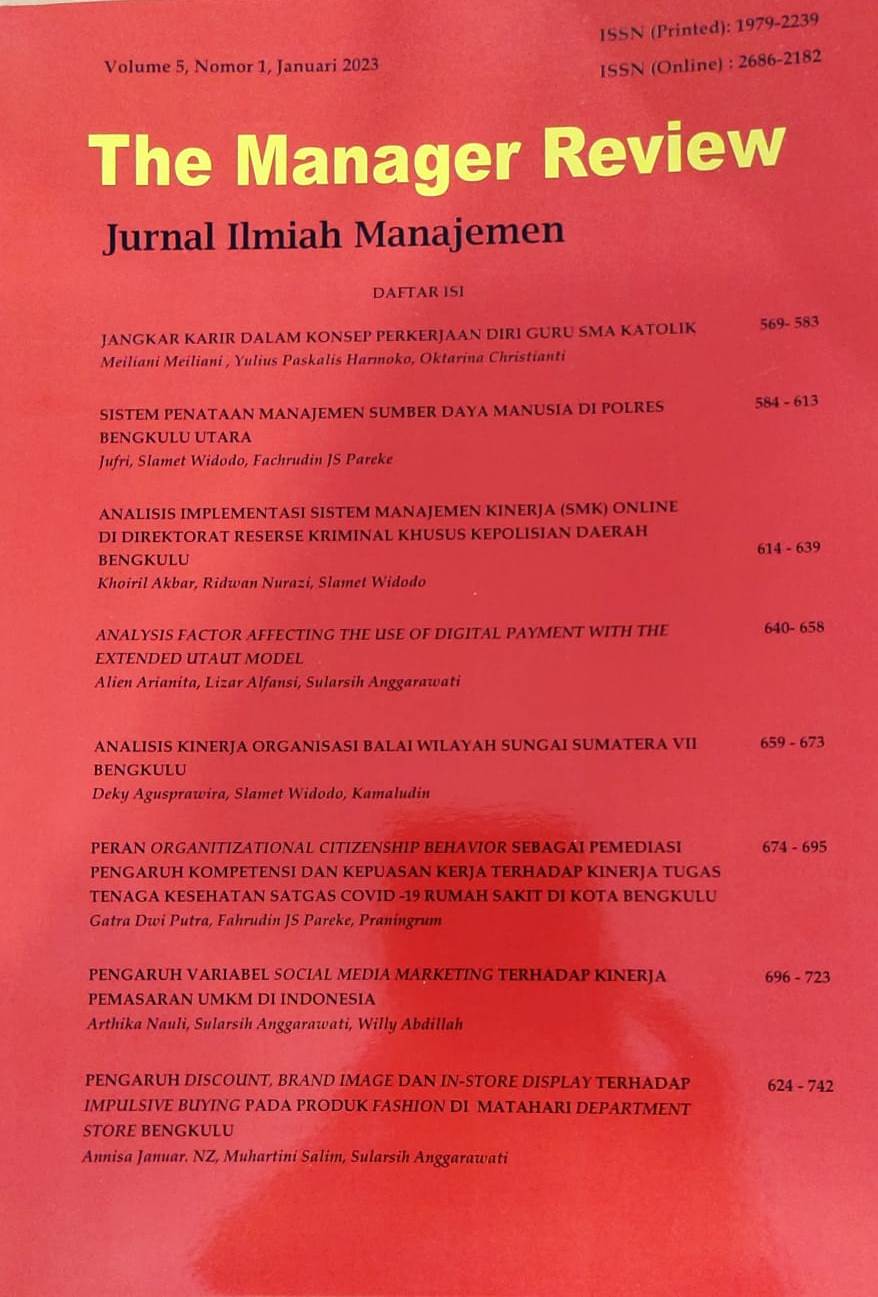Main Article Content
Abstract
Nowadays, public sector organizations have been exposed with tremendous pressure to
adapt to significant change from the external environment (Valle, 1999). The dynamism
of public service needs that are getting better is a demand and necessity at this time,
because of technological developments, consumer preferences, fast service, transparent
and simple bureaucratic systems, and good service governance are demands for the
public as end consumers. Problems related to the complicated bureaucracy in public
sector organizations will be overcome if the organization has a good service culture.
The attitude and behavior of employees is a reflection of the service culture instilled by
the organization. A good service culture will support service innovation by employees
which in turn impacts on organizational performance. Therefore, service culture is
believed to have a significant effect on shaping employee service performance in
Indonesian public agencies.
This study is a quantitative descriptive study that aims to confirm the relationship
between variables in empirical research for the reliability testing of a theory. This study
will only be conducted at one specific time which will show a phenomenon to answer the
research questions to be studied, so that it uses a cross sectional research design.
Respondent samples used in this study were 250 respondents. To answer the research
objectives, researchers used Structural Equation Modeling as a data analysis tool. Data
analysis was performed using PLS Graph 3.0. The results of the study found that one of
the three hypotheses proposed proved significant in this study. The hypothesis that
proved significant was the effect of service innovation on organizational performance,
while the influence of service culture on service innovation and organizational
performance was not proven in this study.
Keywords
Article Details
References
- Anggarawati, S. and Saputra, F.E. (2015). Antecedent and Consequences of Service
- Culture in the Public Sector Service Company in Bengkulu, International
- Conference on Management Science, Yogyakarta
- Bitner, M.J., Booms, B. dan Mohr, L.A. (1994), “Critical service encounter: The
- employee’s view,” Journal of Marketing, Vol. 58, p. 95-106.
- Chin, W. (2001), “PLS-Graph Manual, Version 3.0, unpublished manuscript.
- Homburg, C., Hoyer, W. dan Fassnacht, M. (2002), “Service Orientation of A Retailer’s
- Business Strategy: Dimensions, Antecedences, and Performance Outcomes”,
- Journal of Marketing, Vol. 66, no. 4, p. 53-70.
- Ivanncevich, K.M. (2005). Perilaku dan Manajemen Organisasi, Jakarta: Erlangga
- Liu, B.S.C., Furrer, O. and Sudharshan, D. (2000). “The Relationships between Culture
- and Behavioral Intentions Toward Services”. Journal of Service Research,
- Vol.4, pp. 118-129.
- Lytle, R.S., dan Fimmerman, J.E. (2006), “Service Orientation and Performance: An
- Organizational perpsective”, Journal of Services Marketing, Vol. 20, No. 2, p.
- -147.
- Lytle, R.S., Hom, P.W., dan Mokwa, M.P. (1998), “SER*OR: A Managerial Measure of
- Organizational Service-Orientation”, Journal of Retailing, Vol. 74, No. 4, p. 455-
- Mangkunegara, A.P. (2011). Manajemen Sumber Daya Manusia Perusahaan. Bandung:
- PT. Remaja Rosdakarya.
- Mattila, A.S. (1999). “The Role of Cultural and Purchase Motivation in Service
- Encounter Evaluations”. Journal of Service Marketing, Vol.13, No.4, pp. 376-
- Nelson, T.K. (2007). “Measuring Service and Service Culture in The Tourism
- Industry”. Dissertation in the Hong Kong Polytechnic University.
- Peraturan Menteri Negara Pendayagunaan Aparatur Negara No.PER/09/MPAN/
- /2001 tentang Pedoman Penetapan Indikator Kinerja Utama di
- Lingkungan Instansi Pemerintah.
- Rust, R.T., Anthony, J.Z dan Timothy, L.K. (1995), “Return on Quality (ROQ): Making
- Service Quality Financially Accountable,” Journal of Marketing, Vol. 59, p. 58-
- Schuler, J. (2005). Manjemen Sumber Daya Manusia Mengahadapi Abad Ke-21.
- Jakarta: Erlanga.
- Teo, H.H., Kwok, K.W. dan Izak, B. (2003), “Predicting Intention to Adopt
- Interorganizational Linkages: An Institutional Perspective,” MIS Quarterly,
- Vol. 27, p. 19-49.
- www.antaranews.com/berita/334795/birokrasi-hambat-daya-saing-ekonomiindonesia
- www.merdekainfo.com/wawancara/item/544-jamil-mubarok-koordinator-mti
- Zeithaml, V.A, Bitner, M.J., dan Gremier, D.D (2009), Service Marketing: Integrating
- Customer Focus Across the Firm, Fifth Edition, McGraw-Hill Higher Education,
- Singapore.
References
Anggarawati, S. and Saputra, F.E. (2015). Antecedent and Consequences of Service
Culture in the Public Sector Service Company in Bengkulu, International
Conference on Management Science, Yogyakarta
Bitner, M.J., Booms, B. dan Mohr, L.A. (1994), “Critical service encounter: The
employee’s view,” Journal of Marketing, Vol. 58, p. 95-106.
Chin, W. (2001), “PLS-Graph Manual, Version 3.0, unpublished manuscript.
Homburg, C., Hoyer, W. dan Fassnacht, M. (2002), “Service Orientation of A Retailer’s
Business Strategy: Dimensions, Antecedences, and Performance Outcomes”,
Journal of Marketing, Vol. 66, no. 4, p. 53-70.
Ivanncevich, K.M. (2005). Perilaku dan Manajemen Organisasi, Jakarta: Erlangga
Liu, B.S.C., Furrer, O. and Sudharshan, D. (2000). “The Relationships between Culture
and Behavioral Intentions Toward Services”. Journal of Service Research,
Vol.4, pp. 118-129.
Lytle, R.S., dan Fimmerman, J.E. (2006), “Service Orientation and Performance: An
Organizational perpsective”, Journal of Services Marketing, Vol. 20, No. 2, p.
-147.
Lytle, R.S., Hom, P.W., dan Mokwa, M.P. (1998), “SER*OR: A Managerial Measure of
Organizational Service-Orientation”, Journal of Retailing, Vol. 74, No. 4, p. 455-
Mangkunegara, A.P. (2011). Manajemen Sumber Daya Manusia Perusahaan. Bandung:
PT. Remaja Rosdakarya.
Mattila, A.S. (1999). “The Role of Cultural and Purchase Motivation in Service
Encounter Evaluations”. Journal of Service Marketing, Vol.13, No.4, pp. 376-
Nelson, T.K. (2007). “Measuring Service and Service Culture in The Tourism
Industry”. Dissertation in the Hong Kong Polytechnic University.
Peraturan Menteri Negara Pendayagunaan Aparatur Negara No.PER/09/MPAN/
/2001 tentang Pedoman Penetapan Indikator Kinerja Utama di
Lingkungan Instansi Pemerintah.
Rust, R.T., Anthony, J.Z dan Timothy, L.K. (1995), “Return on Quality (ROQ): Making
Service Quality Financially Accountable,” Journal of Marketing, Vol. 59, p. 58-
Schuler, J. (2005). Manjemen Sumber Daya Manusia Mengahadapi Abad Ke-21.
Jakarta: Erlanga.
Teo, H.H., Kwok, K.W. dan Izak, B. (2003), “Predicting Intention to Adopt
Interorganizational Linkages: An Institutional Perspective,” MIS Quarterly,
Vol. 27, p. 19-49.
www.antaranews.com/berita/334795/birokrasi-hambat-daya-saing-ekonomiindonesia
www.merdekainfo.com/wawancara/item/544-jamil-mubarok-koordinator-mti
Zeithaml, V.A, Bitner, M.J., dan Gremier, D.D (2009), Service Marketing: Integrating
Customer Focus Across the Firm, Fifth Edition, McGraw-Hill Higher Education,
Singapore.
